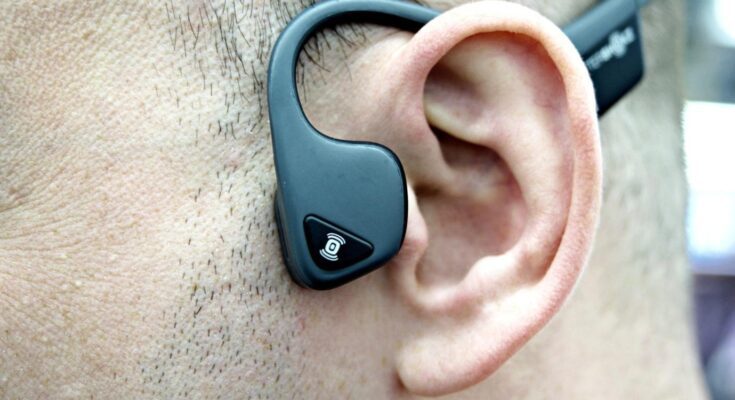Have you heard a lot about bone-conduction headphones? They’ve become a popular alternative to traditional earbuds due to their unique design and technology.
Rather than sitting inside the ear canal, bone conduction headphones sit more towards the cheekbones and use vibrations to transmit sound directly to the inner ear through your skull. This makes them a great option for those who want to listen to music while being aware of their surroundings, such as cyclists or runners.
However, earbuds remain popular for many due to their ease of use and sound quality. Which is best? Who wins the bone-conduction headphones vs. earbuds debate?
It depends on what you’re looking for. This quick guide will explore the differences between bone-conduction headphones and earbuds. Then, we’ll offer guidance on choosing the best option based on your needs.
Pros & Cons of Bone-Conduction Headphones
Instead of sitting inside the ear canal, bone-conduction headphones send vibrations through the bone of your skull to your inner ear. This allows you to hear the audio without blocking your ear entirely.
Sounds cool, right? You bet! They’re even easy to pair using a simple Bluetooth connection.
However, they come with pros and cons, just like any other type of gadget.
Pros
Perhaps the biggest benefit of bone-conduction headphones is that your ears are completely open. This makes them an excellent choice for those who want to remain aware of their environment while listening to music or taking calls. As mentioned, this is especially useful for:
- Runners
- Cyclists
- Other outdoor enthusiasts
You might also notice a marked lack of pressure because they don’t sit inside your ear canal. Traditional earbuds can get uncomfortable over time and even cause ear fatigue. Since bone conduction headphones don’t sit in the ear canal, they relieve the pressure on your eardrum. This can reduce the chances of experiencing discomfort.
Finally, bone-conduction headphones can also be a great option for those with conductive hearing loss. Since the headphones don’t need to pass through the ear canal, they bypass the problem and allow sound to reach the inner ear.
Cons
Bone conduction headphones typically have lower sound quality than traditional headphones. This is because the vibrations don’t produce the same sound level as direct audio transmission to the inner ear.
Additionally, because bone-conduction headphones sit on your cheekbones, they can sometimes pick up background noise. This can be distracting, sure, but it can also reduce audio clarity. Basically, don’t expect total noise-canceling capabilities from bone-conduction headphones.
Finally, bone-conduction headphones can be costly. The advanced technology used to transmit sound through your bones can drive the price up significantly compared to traditional earbuds. However, the cost difference might decrease in the coming years as newer headphones lose their novelty.
Bone-Conduction Headphones vs. Earbuds
Was learning about the pros and cons of bone-conduction headphones not enough to help you decide? Let’s compare bone-conduction headphones vs. earbuds.
Who Will Benefit More from Bone-Conduction Headphones?
Bone-conduction headphones are a great choice for those who love doing outdoor activities. They’re especially great if you love jogging, hiking, or cycling.
Because they don’t block out sound as much as earbuds, it’s easier for you to hear the ambient noise from their environment. This feature is crucial for people who still want to be aware of their surroundings while enjoying music on the go.
They’re also a better option if you have hearing issues. The unique design allows people with hearing aids or cochlear implants to enjoy music without removing their devices.
Who Will Benefit More from Earbuds?
If you commute to work or school by public transportation, earbuds may be the right choice. They’re compact and easy to store, making them an excellent choice for commuters often on the go.
Additionally, if you value crystal-clear sound quality, earbuds may be the way to go. They come in various shapes and sizes, some offering noise-cancellation technology, which can improve the overall listening experience.
Earbuds are likely better if you love listening to deep bass sounds, soothing meditations, or audiobooks. They also offer more compatibility with suitable applications. So, you can connect them to various phone apps to listen to books or podcasts on the go.
The Case for Earbuds
There’s a reason why earbuds have been a staple for decades. They’re small, versatile, and great for those who love bringing their music everywhere. Earbuds allow users to stay connected to their music and phone while on the go without feeling weighed down by a bulky headset or bone-conduction headphones.
Plus, with technological advancements, earbuds have improved even in recent years. Many models offer Bluetooth connectivity, allowing users to connect to their devices wirelessly. This feature is especially handy when working out or out for a run.
And let’s not forget about noise-canceling earbuds. These models offer an isolation level unmatched by any other headphones. This makes them perfect for noisy environments like public transportation or airplane cabins.
If there’s one downside to earbuds, it’s the constant need for replacement. Because they’re so cheap now, they’re often not made well. However, that’s a small price to pay for the convenience and portability that earbuds offer.
For example, if you’re worried about Beats earbud replacement parts, don’t be. Given their popularity, there are plenty of third-party options available online. And even if your earbuds break or get lost, they’re usually quite affordable to replace.
Overall, earbuds are essential for anyone who loves music and staying connected on the go. They offer versatility and convenience that other headphones can’t match.
The Verdict
When deciding between bone-conduction headphones vs. earbuds, it’s essential to consider what type of situations you’ll be in while using them.
If you’re an athlete or struggle with hearing, bone-conduction headphones may be the better choice. However, traditional earbuds may be the way to go if you’re an audiophile or a commuter.
Ultimately, it’s all about finding the right fit for your needs. While you’re comparing your options, consider wireless headphones. We’ve compiled a guide to the best wireless headphones for you to start your search.



